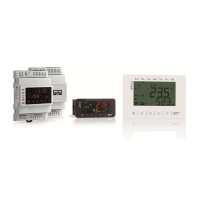EVCO S.p.A.
EV3 MVC & EVD MVC | Application manual ver. 1.0 | Code 144EV3MVI104
page 48 of 72
Regulation of the supply fans follows this order of priority:
- If a defrost of the recovery heat exchanger is in progress the fans follow the algorithm described in the relevant paragraph,
while if a defrost of the refrigeration unit is active the fans are switched off unless this happens because the compressor is
switched off (in which case ventilation operates normally).
- If the digital input forced ventilation is configured and active, the supply fan speed is determined by parameter P13.
- If a probe such as remote control probe is configured and not in alarm mode, the fan speed is the same as that of the probe
as set by parameters I29 and I30 that set the value of the output in relation respectively to the minimum and maximum
value of the input.
- If the CO
2
or differential pressure sensor is configured and not in alarm mode regulation is based on this sensor as described
in the relevant paragraphs.
- If the humidifier in heating (C45) is enabled and the humidity sensor is configured and not in alarm mode or if the digital
input dehumidifier request is configured and activated, regulation is based on the value of the aforesaid inputs as described in
the relevant paragraph.
- If none of these situations exist, the fan speed is determined by the current setpoint (manual or timer settings).
All ventilation regulations with the exception of remote control, use a fixed incremental step set by parameter C12, its intervals defined
by parameter C13.
The fan speed is always limited by the minimum (C05) and maximum (C06) values, also taking into account any forced ventilation
supporting the refrigeration circuit (C14) and the electric coils (C15, C16) that are able to increase the minimum fan speed when such
functions are activated.
During the active defrost phases of the refrigeration unit, the fans are switched off to maintain any localised heat on the coil that does
the defrosting and avoid an inflow of cold air and pressure imbalances in the room.
If the mixing chamber damper is completely closed, the return fan is switched off to avoid possible imbalances.
External air damper
When the digital output External air damper is configured, the fans will only switch on if this damper is open.
Once the damper is open
the opening time set by A10 elapses before the fans are switched on
.
If the digital input External air damper open limit switch is configured, the fans remain off until the damper halts contact.
When the fans are switched off the external air damper is also closed.
9.5 Regulating the recovery heat exchanger
The controller can manage 3 different types of recovery heat exchanger, configured using parameter C27:
- Cross-flow
- Rotary
- Thermodynamic (compressor).
In order to use this function, the recovery heat exchanger/bypass damper or Compressor (if the recovery heat exchanger is
thermodynamic) relays must be configured.
Cross-flow recovery heat exchanger is a passive system, meaning that when activated the corresponding relay is in rest position. When
the recovery heat exchanger is inactive the corresponding relay opens the bypass damper.
Rotary and thermodynamic recovery heat exchangers are active systems meaning that the corresponding relay must be active for the
exchanger to operate.
Irrespective of the type, the recovery heat exchanger is always operating other than in the following situations when it is deactivated:
- If the fans are in alarm mode or the machine in standby mode (only in the case of active recovery heat exchanger since the
energy exchange would be nil while there would be energy consumption required to keep the exchanger active)
- If the mixing chamber damper is completely closed for the same reason as above (in this case the return fan is switched off)
- If the free heating or free cooling functions are activated.
Defrosting cross-flow or rotary recovery heat exchanger
During the winter cycle, the recovery heat exchanger exchanges heat between the flow of expelled air (hot and humid) and the input
air (cold and dry). If the external air is particularly cold, the expelled air flow temperature can fall to freezing point, risking obstruction
of the exchanger and impeding normal air flow.
To prevent this happening it is necessary to prevent excessive lowering of the expelled air flow temperature by constantly monitoring
this temperature (expelled air temperature) and, when needed, first slowing down just the supply fan and then both fans.
Regulation happens in the neutral zone with setting d09, band d10, step C12 and time C13 according to the temperature of the
Expulsion probe
: if the temperature is too low
(<d09 - d10/2)
the supply fan speed is lowered compared to that of the return fan
speed up to a maximum differential (d12) always taking into account any balancing of the C35 speeds that remains valid at all times; if

